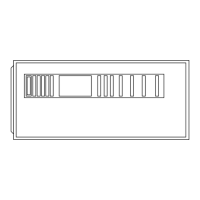going to Ignition-Lockout. Lockout will be reset auto-
matically after three hours, by momentarily interrupting
115 vac power to the furnace, or by interrupting 24 vac
power at SEC1 or SEC2 to the furnace control CPU (not at
W, G, R, etc.)
If flame is proved when flame should not be present, the
furnace control CPU will lock out of Gas-Heating mode
and operate the inducer motor IDM until flame is no longer
proved.
e. Blower-On Delay- If the burner flame is proven, the
blower motor is energized on HEAT speed 66 seconds after
the gas valve GV is energized.
Simultaneously, the electronic air cleaner terminal EAC-1
is energized and remains energized as long as the blower
motor BLWM is energized.
f. Blower-Off Delay- When the thermostat is satisfied, the
R-to-W circuit is opened, de-energizing the gas valve GV,
stopping gas flow to the burners, and de-energizing the
humidifier terminal HUM. The inducer motor IDM will
remain energized for a 15-second post-purge period. The
blower motor BLWM and air cleaner terminal EAC-1 will
remain energized for 90, 120, 150, or 180 seconds (depend-
ing on the blower-OFF delay selection). The furnace
control CPU is factory-set for a 120-second blower-OFF
delay.
Table 8—Vent Pipe
Termination Clearances
LOCATION
CLEARANCE (FT)
U.S.A. Canada
Above grade level or above
anticipated snow level
11†
Dryer / Water heater vent 00
Plumbing vent stack 00
Any mechanical fresh air in-
take
See Note 4 See Note 6
For furnaces with an input ca-
pacity of 100,000 Btuh or less-
–from any non-mechanical air
supply (windows or doors
which can be opened) or com-
bustion air opening
11
For furnaces with an input ca-
pacity greater than 100,000
Btuh–from any non-
mechanical air supply (win-
dows or doors which can be
opened) or combustion-air
opening
13
From service regulator vent,
electric and gas meters, and
relief equipment
See Note 6 See Note 6
Above grade when adjacent to
public walkway
See Note 3 See Note 3
† 18 in. above roof surface
NOTES:
1. If installing 2 adjacent Furnaces, refer to Multiventing and Vent Terminations
section for proper vent configurations.
2. When locating vent terminations, consideration must be given to prevailing
winds, location, and other conditions which may cause the appliance’s flue
gases to be taken into adjacent air-intakes of other appliances. Intake of flue
gases with combustion-air can cause poor combustion, inlet condensate
problems, and accelerated corrosion of heat exchangers.
3. Vent termination shall be less than 2 ft horizontal and 7 ft above public
walkway or where condensate vapor or droplets may be a hazard.
4. Vent termination shall be at least 3 feet above any forced draft inlets within
10 feet horizontal. Vent termination shall be at least 3 feet horizontal from other
direct vent appliances intake unless otherwise specified by manufacturer.
5. 3 ft radius of furnace vent terminal and 1 ft horizontally from vertical
centerline of furnace vent terminal.
6. Above a meter/regulator within 3 feet horizontally of vertical centerline of
meter/regulator vent outlet to a maximum vertical distance of 15 ft.
Fig. 41—Sidewall Termination with Straight Pipe
A96210
MAINTAIN 12-IN.
CLEARANCE
ABOVE HIGHEST
ANTICIPATED SNOW
LEVEL OR GRADE,
WHICHEVER IS
GREATER.
VENT
12″ MINIMUM
OVERHANG OR ROOF
6-IN. MINIMUM
CLEARANCE BETWEEN
WALL AND END OF VENT
PIPE.
10-IN. MAXIMUM PIPE LENGTH
Fig. 40—Sidewall Termination with 2 Elbows
(Preferred)
A96192
MAINTAIN 12-IN.
CLEARANCE
ABOVE HIGHEST
ANTICIPATED SNOW
LEVEL OR GRADE,
WHICHEVER IS
GREATER.
90°
VENT
12″ MINIMUM
OVERHANG OR ROOF
Fig. 39—Roof Termination (Preferred)
A96191
ROOF
VENT
MAINTAIN 12-IN. MINIMUM
CLEARANCE ABOVE HIGHEST
ANTICIPATED SNOW LEVEL.
MAXIMUM OF 24 IN. ABOVE ROOF.
34
→

